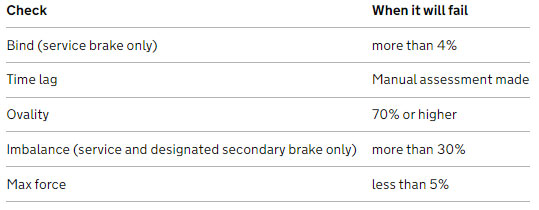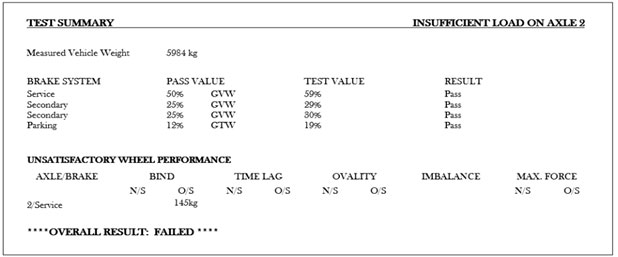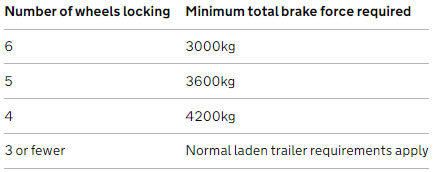
Commercial vehicle maintenance is a very large subject; and must include the responsibilities and systems involved in keeping vehicles in a roadworthy condition, regardless of operating conditions, fleet size or vehicle type.
Ensuring that the vehicles are maintained in an operationally compliant condition is not only the responsibility of the operator, but equally falls on the shoulders of the driver who is in charge of the vehicle(s). Items that are covered here include:
As stated in the Guide to Maintaining Roadworthiness, there must be a firm management commitment to review and improve maintenance systems where defects are found on vehicles or when the fleet size or the nature of the business changes.
Many experienced operators have, over time, found best practice methods of running their vehicle/trailer fleets without any detriment to the compliance requirements expected of them. By using tried and tested methods and ensuring their management and driver workforce all pull in the same direction, the result is invariably a fully compliant operation, that is profitable, operating up-to-date modern vehicles and equipment and invariably with full order books.
Key points of a good maintenance system
The following are important key points as a guide to help you plan and set up a compliant and effective maintenance system for your vehicles:
Legislation
If you are an operator of heavy goods vehicles (HGVs) and public service vehicles (PSVs), you must meet the governing legislation that the Traffic Commissioners have outlined in their Statutory Guidance Document. This is now in legislation, so if you operate within the UK or outside of the UK, you should ensure vehicles are roadworthy.
Operators must comply with the declaration they give to the relevant traffic commissioner that they will ensure that their vehicles are operated in a fit and serviceable condition. If operators intend making any changes to their maintenance arrangements, they must update the details on the vehicle operator licensing system.
Free Rolling Tyres: change to the annual test
A robust tyre management system is an essential part of any operator’s maintenance system. This includes in-service tyres, which are appropriate for the vehicle, and positions, which they are fitted to.
Free Rolling Tyres
A tyre marked with the term ‘FRT’ on the sidewall stands Free Rolling Tyre.
This marking means the tyre is designed for use on axles of a motor vehicle and trailer axles, other than front steering and drive axles.
Currently, vehicles and trailers, which are fitted with FRTs on drive axles, are categorised as a major item at annual test and will result in a failure.
FRTs on steering axles
From April 2023, FRTs fitted to front steering axles will be treated as a major deficiency at annual test.
This means vehicles and trailers will fail the annual test.
Before then, FRTs fitted to steering axles may be issued with an advisory at annual test.
Prepare for the change
We will update the HGV and PSV inspection manuals early next year to reflect the change for FRTs on front steering axles.
Operators using vehicles and/or trailers, which are fitted with FRTs on steering axles, have 6 months to make changes and ensure they will avoid a failure at annual test.
Tyre checks should be part of a driver’s daily walk around checks – as well as the regular management controls that operators need to have in place.
Vehicles, which are being used for a driving test, must be compliant.
DVSA will refuse to carry out a test if vehicles are not in a roadworthy condition.
OCRS
A key component of managing your commercial vehicle compliance is the Operator Compliance Risk Score – OCRS.
Every transport operator should be registered.
Roller Brake Test Reports (RBTs)
Understand your HGV and/or trailer brake test report
You should get your HGV or trailer’s brakes tested by a roller brake tester (RBT) at least 4 times per year, including at the MOT.
Your vehicle must be loaded for a brake test – ideally to at least 65% of its total maximum weight. It can only be tested unladen if it cannot be loaded due to design limitations or the type of load it normally carries. Check what vehicles can be tested unladen.
The brake test report will tell you whether you passed or failed the test. It has three sections that include:
You should use this report to:
You should keep a printout of the brake test and attach it to your vehicle’s safety inspection record.
Section 1: information about your vehicle

The first section of the report contains information about your vehicle including:
Depending on the type of vehicle or trailer, the design weight will be displayed as either:
The DTp number should match the one shown on the vehicle-plating certificate. Your test result may be incorrect if it is wrong.
Section 2: your vehicle’s brake performance results by axle

The report will show the axle weights and the results of checks on your vehicle’s brakes for:
More information concerning Bind, Time Lag, Ovality, Imbalance and Max Force can be found below.
The results are ordered by axle and will show the results for the nearside (N/S) and offside (O/S) readings of the service brake and parking brake. They will also include readings for a secondary brake if your vehicle has an independent control brake system, but not if it is a split system.
Table 1 (below) shows what is checked during the test and when it will fail.

Axle weight
The report will show the weight of each axle in kg. It must be at least 50% of the design axle weight displayed on the manufacturer’s plate and plating certificate.
You should aim for each axle to weigh at least 65% of the design axle weight. If any axle weighs less than 65%, an ‘insufficient load’ message will be included in the test summary. This does not include vehicle front axles.
Your wheels may have locked too quickly to give accurate results if your vehicle passed the test but the report included an ‘insufficient load’ message. You should get another brake test with a properly loaded vehicle as soon as you can.
Bind
The bind reading checks to see if the brakes bind when the brake is not applied. It is only displayed against the service brake performance.
The vehicle will fail if the brake bind is more than 4% of the measured axle weight. The result will be shown as either a ‘Pass’ or ‘Fail’. If it is a fail, the reading will be shown in kg under the ‘Unsatisfactory wheel performance’ heading.
Time lag
Time lag checks that there is not a delay between the brake being applied and it starting to work. It is not measured by the roller test computer, so will always be shown as a pass on your report.
The assessor can override the result if they notice a significant lag during testing. They will let you know if your vehicle fails for this after the test.
Ovality
Ovality measures if there is any difference in the braking effort as each wheel rotates. It is only checked on HGV’s steered axles.
The vehicle will fail if there is a difference of more than 70% between the highest and lowest brake reading at a steady pedal pressure.
The result will be shown as either a ‘Pass’ or ‘Fail’. If it is a fail, the reading will be shown as a percentage under the ‘Unsatisfactory wheel performance’ heading.
Imbalance
Imbalance across an axle is calculated using the maximum brake efforts at each wheel. These are shown in the results in kg, along with the imbalance across an axle as a percentage.
The vehicle will fail if the brake imbalance is more than 30%. However, this does not apply if both wheels lock, or if one wheel locks and the braking effort of the locked wheel is less than that of the other.
You cannot fail due to excessive parking brake imbalance, but the result will be included on your report.
If your vehicle passes the imbalance check but the imbalance is over 25% you should investigate why this is and look to adjust your brakes to lower the imbalance. Imbalanced brakes can cause the vehicle to pull to one side under heavy braking.
Max force
The report shows the maximum brake effort at each wheel in kg. Your vehicle will fail if either:
If your wheel locks during the check, the report will show the reading followed by an (L). You will pass the efficiency test if more than half the wheels of a braking system lock.
Section 3: test summary

The test summary shows how the vehicle or trailer has performed during the brake test.
It shows:
If the designated secondary brake is a split-system, two secondary brake efficiency results are shown, one for each half of the system. However, split-system secondary brake efficiency is no longer part of the MOT so you can ignore this.
If your test value says ‘FWA’
If any of your test value results have front wheel lock allowance ‘(FWA)’ after it, one or more of your front wheels locked during the test.
For trailers, front wheel lock allowance (FWA) only applies to one or two front steered axles on full drawbar trailers.
If a result says, ‘Pass (Locks)’
If your report shows a result of ‘Pass (Locks)’, your vehicle will have passed because more than half of its wheels locked during the test. Although your vehicle passed, your wheels may have locked too quickly to give accurate results. If this was because your vehicle was not loaded to at least 65% of its weight, you should get another brake test with a properly loaded vehicle as soon as you can.
If a result says ‘Fail (alternative?)’
If your report shows a result of ‘Fail (alternative?) next to a designated secondary brake that is an independent control, it did not meet the efficiency requirement. The tester will check if the vehicle also has a split-system service brake. If each half of the split system meets the secondary efficiency required, then the vehicle can be passed for secondary using this alternative system.
You can ignore any ‘Fail (alternative)’ result for a designated secondary brake that is a split-system, as split-system secondary brake efficiency is no longer part of the MOT.
Understanding the brake test report for an unladen tri-axle semi-trailer
Due to the difficulty of loading a tri-axle semi-trailer for a brake test, it can be tested unladen.
To pass the test, the service and parking brake systems must achieve a specified level of brake force depending on the number of wheels that lock.
This test only applies to unladen tri-axle semi-trailers. It is not used for any other type of unladen trailer.
Service brake performance
The table shows the minimum total brake force that the service brake must achieve depending on the number of wheels that lock during the test.
Table 2

Parking brake performance
The table shows the minimum total brake force that the parking brake must achieve depending on the number of wheels that lock during the test.
Table 3

Further Information
For further information, please select and download the relevant pdf files at the links below.
Workplace Transport Safety (HGV)
Guide to Maintaining Roadworthiness (HGV & PCV)
Public Service Vehicle (PSV) Inspection Manual